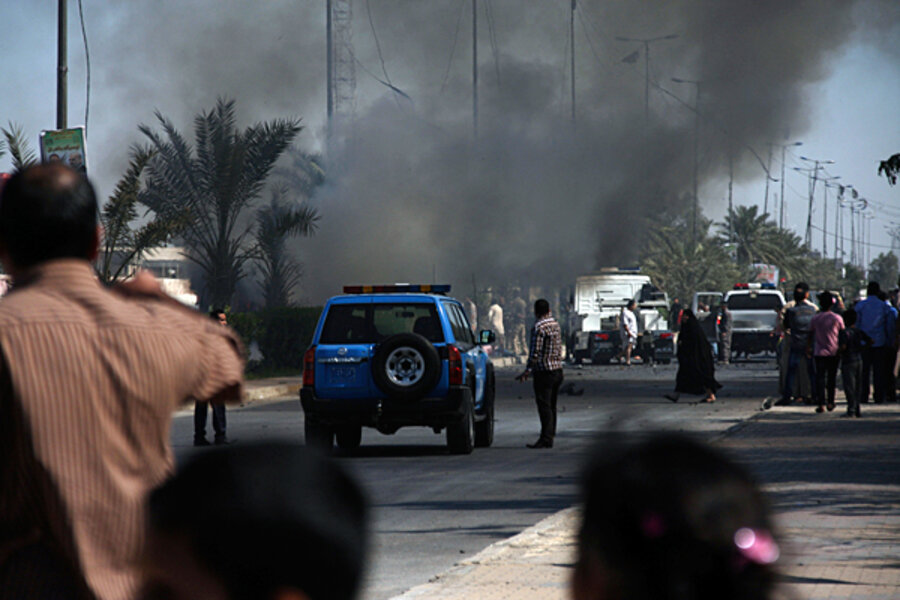Bombs rock Baghdad, ten years after Iraq invasion announced
Loading...
• A daily summary of global reports on security issues.
Bombs went off in food markets, residential neighborhoods, and checkpoints in and around Baghdad today, on the tenth anniversary of the US announcement of its invasion of Iraq.
The Wall Street Journal reports there were at least 15 attacks, mostly car bombs, between 8 and 9 am local time, primarily in Shiite neighborhoods of the capital and Iraqi Army locations. According to the Associated Press, at least 56 were killed and more than 200 were wounded.
No group has claimed responsibility yet, but the Journal reports that they bear similarities to previous violence claimed by Al Qaeda in Iraq (AQI), which has accepted responsibility for a number of recent attacks, including one on March 17 that targeted the justice ministry. According to AP, AQI "favors spectacular, coordinated bombings intended to undermine public confidence in the Shiite-led government."
The attacks are not surprising, and would not be even if it was not an important anniversary. After declining, then leveling off from a peak in 2006 and 2007, sectarian violence in Iraq began rising once again last year. The rise in attacks came on the heels of the completion of the US troop withdrawal and as political infighting brought Sunni-Shiite tensions to the forefront.
As The Christian Science Monitor reports, the concrete walls surrounding the Iraqi parliament are going back up, only a year after they were taken down in a nod to improved security in the capital. For the most part, the attacks appear to be Sunni insurgent attacks attempting to destabilize the Shiite-led government, which has taken steps to block Sunni participation in politics.
Prior to the US invasion, predominantly Sunni Baathists, led by Saddam Hussein, dominated the government and security forces. Shiites have most power and influence now, and the government of Prime Minister Nouri al-Maliki has consistently marginalized his Sunni Arab political opponents.
The country has also been rocked by nearly weekly Sunni protests demanding that Iranian influence in the country be curtailed and that their lack of standing in the post-war power-sharing government that increasingly does anything but distribute power among Shiites and Sunnis be mitigated. In 2012, Sunni Vice President Tariq al-Hashemi fled Baghdad prior to being sentenced to death on charges of leading a death squad that targeted Shiite leaders. He said the charges were fabricated for political advantage.
BBC journalist Jim Muir describes the forces that have left the unity government a hollow shell, both a reaction to attacks by Sunni groups and a catalyst for further attacks:
[Sunni leaders] charge that [Prime Minister Nour Maliki] has monopolised power by keeping control of the still-vacant defence and interior ministries, making himself almost entirely in charge of a security apparatus which they assert has been increasingly victimising Sunnis.
"The political process which is supposed to have brought democracy to Iraq, in fact brought one party and one person who are ruling Iraq," said Deputy Prime Minister Saleh al-Mutlak, another senior Sunni figure, referring to Mr Maliki and his Shia Daawa Party.
"There is no real participation by others, and the country is heading towards a harsh, backward dictatorship without a shred of wisdom."
As the Monitor reports:
"These multiple identities competing with each other is what fuels the crisis you see in Iraq's political landscape," says an Arab analyst with long experience in Iraq who asked not to be named. "In 2003 when the genie of ethno-sectarianism came out of the bottle it gave rise even to subsectarian divisions.... Communities live in fear of each other."
The New York Times reports that although Baghdad is flooded with foreign journalists covering the anniversary, it is barely a blip on the radar for most Iraqis – day-to-day life is still too unpredictable.
“If our situation were better than this, we would surely remember that day when the Americans came to free Iraq and gave us the chance to build a better future,” Mr. Shimari said. “But the Americans didn’t give us that chance. They did all the things possible to ensure that Iraq is going to be ruined.”
…
Another journalist, Sabah Sellawi, the editor of the newspaper Maysan, said, “The instability in Iraq is more important than this day.”
On the 10th anniversary of the US invasion of Iraq, former and current Monitor journalists who covered the war are looking at where Iraq stands today and how things stood at the peak of the war:
* Ten years after invasion, Iraq remains dangerously divided – In the new Iraq, old sectarian fears remain. Around Baghdad's Green Zone, concrete walls pulled down a year ago are going back up.
* The day the conflict changed – Ten years after the Iraq invasion, reporter Scott Peterson recalls the day a suicide attack threw him out of bed in a formerly quiet Baghdad neighborhood – and blew a hole in any sense that the war was keeping its distance.
* On the road to Baghdad for 17 days – Andy Nelson, who photographed the US invasion of Iraq, recalls the pulling down of Saddam's statue – and early signs of chaos.
* The Iraq war: a timeline – A photo collection depicting the main events of the conflict.








